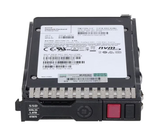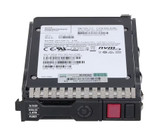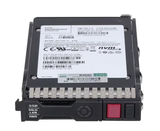Unleashing Turbocharged Performance for ProLiant Gen10 Data Dynamos
HPE 1.6TB 2.5-Inch Small Form Factor NVMe U.2 PCIe x4 SCN Mixed Use SSD for ProLiant Gen10 Servers: A Comprehensive Overview
The HPE 1.6TB 2.5-inch Small Form Factor Digitally Signed Firmware NVMe U.2 PCIe x4 SCN Mixed Use Solid State Drive is a high-performance storage solution designed specifically for Hewlett Packard Enterprise (HPE) ProLiant Gen10 servers. Engineered to meet the demands of mixed-use workloads, this SSD combines speed, reliability, and enterprise-grade features to enhance server performance in data-intensive environments. This article provides a detailed, structured, and organized exploration of its specifications, features, benefits, compatibility, and ideal use cases.
1. Introduction
In modern enterprise IT environments, storage performance is critical to ensuring efficient data processing, low latency, and scalability. The HPE 1.6TB NVMe U.2 SSD is tailored for HPE ProLiant Gen10 servers, offering a robust solution for businesses requiring high input/output operations per second (IOPS), fast data transfers, and reliable endurance. With its 2.5-inch small form factor (SFF), PCIe x4 interface, and mixed-use design, this SSD addresses the needs of applications ranging from databases to virtualization. Its digitally signed firmware enhances security, making it a trusted choice for mission-critical deployments.
2. Key Specifications
The HPE 1.6TB NVMe U.2 SSD boasts a comprehensive set of specifications that cater to enterprise requirements:
- Capacity: 1.6TB
- Form Factor: 2.5-inch Small Form Factor (SFF)
- Interface: PCI Express 3.0 x4 (NVMe U.2)
- Workload Type: Mixed Use (MU)
- NAND Flash Memory Type: Triple-Level Cell (TLC)
- Carrier Type: HPE Smart Carrier NVMe (SCN)
- Plug Type: Hot-Pluggable
- Connectivity: Dual Port
- Height: 15.00 mm (0.60 inch)
- Endurance:
- Drive Writes Per Day (DWPD): 3–5 (varies by model)
- 30-Day Writes: Up to 14,600 TB
- Performance:
- Max Sequential Read Throughput: Up to 6,500 MiB/s
- Max Sequential Write Throughput: Up to 2,700 MiB/s
- Random Read IOPS (4KiB, Q=16): Up to 180,000
- Random Write IOPS (4KiB, Q=16): Up to 220,000
- Max Random Read IOPS (4KiB): Up to 950,000 @ Q256
- Max Random Write IOPS (4KiB): Up to 220,000 @ Q256
- Random Read Latency (4KiB, Q1): 93 µs
- Random Write Latency (4KiB, Q1): 25 µs
- Platform Support: HPE ProLiant Rack/Tower/BladeSystem Servers, HPE Synergy
These specifications highlight the SSD’s ability to handle demanding workloads while maintaining reliability and efficiency.
3. Core Features
The HPE 1.6TB NVMe U.2 SSD is packed with features that distinguish it in the enterprise storage market.
Digitally Signed Firmware
- Security:
The digitally signed firmware ensures that the drive’s software originates from a trusted source, protecting against unauthorized modifications and potential security threats.
- Data Integrity:
This feature safeguards critical data, making the SSD suitable for industries with strict compliance requirements, such as finance and healthcare.
NVMe U.2 Interface
- High Bandwidth:
The PCIe 3.0 x4 interface delivers significantly higher throughput than traditional SAS or SATA SSDs, enabling faster data transfers.
- Low Latency:
NVMe protocol reduces communication overhead, resulting in lower latency for read and write operations.
- U.2 Compatibility:
The U.2 form factor supports hot-plugging and is backward-compatible with SAS/SATA bays, offering flexibility in server configurations.
Smart Carrier NVMe (SCN)
- Ease of Use:
The HPE Smart Carrier provides status indicators and a “do not remove” button to prevent accidental data loss during maintenance.
- Monitoring:
Integrated with HPE’s SmartSSD Wear Gauge, it allows administrators to monitor drive health and lifespan, ensuring proactive maintenance.
Mixed-Use Workload Optimization
- Versatility:
Designed for mixed-use workloads, the SSD balances read and write performance, making it ideal for applications with varying I/O patterns.
- Endurance:
With a DWPD rating of 3–5, it supports frequent data writes, ensuring longevity in write-intensive environments.
4. Performance Metrics
The HPE 1.6TB NVMe U.2 SSD delivers exceptional performance, as evidenced by its metrics:
- Sequential Performance:
- Read: Up to 6,500 MiB/s, enabling rapid access to large datasets.
- Write: Up to 2,700 MiB/s, supporting fast data commits.
- Random Performance:
- Read IOPS: Up to 180,000 (4KiB, Q=16), ideal for transactional databases.
- Write IOPS: Up to 220,000 (4KiB, Q=16), ensuring efficient write-heavy operations.
- Max Read IOPS: 950,000 @ Q256, showcasing scalability under high queue depths.
- Latency:
- Read: 93 µs (4KiB, Q1), minimizing delays in time-sensitive applications.
- Write: 25 µs (4KiB, Q1), enhancing responsiveness.
These metrics position the SSD as a top performer for enterprise workloads requiring both speed and consistency.
5. Compatibility with HPE ProLiant Gen10 Servers
The SSD is specifically designed for HPE ProLiant Gen10 servers and HPE Synergy platforms, ensuring seamless integration. Compatible models include:
- HPE ProLiant DL Series:
DL360 Gen10, DL380 Gen10, DL325 Gen10, and more.
- HPE ProLiant ML Series:
ML350 Gen10 (Base, High Performance, SMB, Solution, Special Server).
- HPE Synergy:
480 Gen10 Compute Module, 660 Gen10 Compute Block, and others.
The SSD is supported in servers with 2.5-inch Smart Carrier NVMe (SCN) drive bays. For optimal performance, HPE recommends using a single type of SSD (e.g., NVMe only) to avoid inconsistencies caused by mixing SAS, SATA, or NVMe drives.[](https://cloudninjas.com/collections/hpe-proliant-dl380-gen10-ssd-upgrades)
6. Benefits for Enterprises
The HPE 1.6TB NVMe U.2 SSD offers numerous advantages for enterprise environments:
- Enhanced Performance:
Accelerates data access and processing, reducing bottlenecks in virtualized environments and database applications.
- Reliability:
Backed by HPE’s rigorous testing (up to 3.35 million hours), ensuring dependable operation in 24/7 environments.(https://www.storagepartsdirect.com/hpe-875876-001-1.6tb-2.5in-nvme-pcie-mixed-use-g9-g10-ssd/)
- Security:
Digitally signed firmware protects against firmware tampering, enhancing data trust.
- Flexibility:
Hot-pluggable design and U.2 compatibility simplify upgrades and maintenance.
- Cost-Effectiveness:
Balances performance and endurance, offering a strong price-to-performance ratio for mixed-use workloads.
- Scalability:
Supports high IOPS and throughput, accommodating growing data demands.
7. Ideal Use Cases
The SSD’s mixed-use design makes it suitable for a variety of enterprise applications, including:
- Databases:
High random IOPS and low latency support transactional and analytical databases (e.g., SQL Server, Oracle).
- Virtualization:
Fast read/write performance ensures smooth operation of virtual machines and hypervisors (e.g., VMware, Hyper-V).
- Big Data Analytics:
High sequential throughput enables rapid processing of large datasets.
- Web Servers:
Low-latency access improves response times for web applications.
- Content Delivery Networks (CDNs):
Efficient data retrieval enhances content streaming and caching.
- High-Performance Computing (HPC):
Supports compute-intensive workloads in research and simulation environments.
8. Comparison with Other SSD Types
NVMe vs. SAS/SATA: The HPE NVMe SSD outperforms SAS and SATA SSDs in throughput, IOPS, and latency, making it ideal for high-performance applications. However, SAS SSDs may offer higher endurance for write-intensive workloads, while SATA SSDs are more cost-effective for read-heavy tasks.
9. Installation and Maintenance
Installation
1. Verify Compatibility:
Confirm the server model supports 2.5-inch NVMe U.2 drives (e.g., ProLiant DL380 Gen10 with NVMe backplane).
2. Power Down (if required):
For non-hot-pluggable bays, shut down the server to avoid data loss.
3. Insert SSD:
Align the SSD with the Smart Carrier NVMe bay and insert firmly until it locks.
4. Power On:
Boot the server and verify the drive is detected in the BIOS or HPE Integrated Lights-Out (iLO).
5. Configure:
Use HPE Smart Storage Administrator or OS tools to configure RAID or initialize the drive.
Maintenance
- Monitor Health:
Use HPE SmartSSD Wear Gauge via iLO to track endurance and predict failures.
- Firmware Updates:
Regularly check HPE’s support portal for firmware updates to maintain security and performance.
- Hot-Plug Support:
Replace or upgrade drives without downtime in supported configurations.
10. Conclusion
The HPE 1.6TB 2.5-inch Small Form Factor NVMe U.2 PCIe x4 SCN Mixed Use SSD is a powerful and versatile storage solution for HPE ProLiant Gen10 servers. Its combination of high performance, robust endurance, and enterprise-grade features like digitally signed firmware makes it an excellent choice for mixed-use workloads. From accelerating databases to supporting virtualization and analytics, this SSD delivers the speed, reliability, and scalability that modern enterprises demand. By leveraging its NVMe U.2 interface and Smart Carrier design, businesses can enhance server efficiency while maintaining data security and operational flexibility.
For organizations investing in HPE infrastructure, this SSD offers a compelling balance of performance and value, ensuring optimal returns on storage upgrades. To ensure compatibility and maximize benefits, consult HPE’s technical guides or authorized resellers before deployment.
Recent Posts
-
Igniting High-Performance Storage for ProLiant Gen9 & Gen10 Servers: HPE 1.6TB NVMe U.2 SSD
HPE 1.6TB NVMe U.2 SSD: The Turbocharged Heartbeat of ProLiant Performance The HPE 1.6TB 2.5-in …Apr 15th 2025 -
The Turbocharged Heartbeat of ProLiant Performance: HPE 1.6TB NVMe U.2
HPE 1.6TB 2.5-Inch Small Form Factor NVMe U.2 SSD: A Comprehensive Overview for ProLiant Gen8, …Apr 15th 2025 -
Unleashing Enterprise Performance: Exploring the HPE 1.6TB NVMe U.2 PCIe SCN Mixed Use SSD for ProLiant Gen10 Servers
HPE 1.6TB 2.5-Inch Small Form Factor NVMe U.2 PCIe SCN Mixed Use Solid State Drive for Pr …Apr 14th 2025




